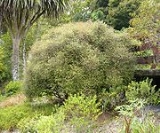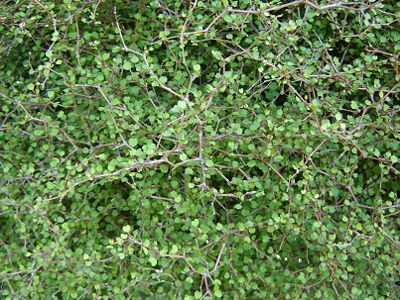
Muehlenbeckia astonii
Encyclopedia
Muehlenbeckia astonii is an ornamental plant
in the Polygonaceae
family. It is an endemic New Zealand
shrub
. It is a curious plant and very distinct from any other native New Zealand species. It is leafless in winter. It has a great number of fine reddish brown to reddish orange branches that zigzag with one another to form a dense ball, up to 2 - 3 m. round. It has very small heart-shaped leaves (only a few millimetres) that grow in clusters of 2 or 3, or alternate along the longer branchlets.
Flowers are tiny and grow in clusters of 2 to 4, less than 1 cm diameter, greenish to white or pinkish white. Fruit about 3 to 4 mm in diameter, dark, three-angled nut, surrounded by the remnants of the flower.
Muehlenbeckia astonii is found only at the southern tip of the North Island (Palliser Bay) and on the eastern side of the South Island from northern Marlborough to Birdlings Flat at the south-west edge of Banks Peninsula. It occurs on the coast and on lowlands, especially terraced riverbeds.
The English or Maori names are seldom used.
Its unusual form makes it an interesting garden plant, as a shelter plant in exposed situations or as an informal hedge. It needs dry conditions. It can easily be pruned to shape.
It is propagated by cuttings and seed.

Ornamental plant
Ornamental plants are plants that are grown for decorative purposes in gardens and landscape design projects, as house plants, for cut flowers and specimen display...
in the Polygonaceae
Polygonaceae
Polygonaceae is a family of flowering plants known informally as the "knotweed family" or "smartweed family"— "buckwheat family" in the United States. The name is based on the genus Polygonum and was first used by Antoine Laurent de Jussieu in 1789 in his book, Genera Plantarum. The name refers...
family. It is an endemic New Zealand
New Zealand
New Zealand is an island country in the south-western Pacific Ocean comprising two main landmasses and numerous smaller islands. The country is situated some east of Australia across the Tasman Sea, and roughly south of the Pacific island nations of New Caledonia, Fiji, and Tonga...
shrub
Shrub
A shrub or bush is distinguished from a tree by its multiple stems and shorter height, usually under 5–6 m tall. A large number of plants may become either shrubs or trees, depending on the growing conditions they experience...
. It is a curious plant and very distinct from any other native New Zealand species. It is leafless in winter. It has a great number of fine reddish brown to reddish orange branches that zigzag with one another to form a dense ball, up to 2 - 3 m. round. It has very small heart-shaped leaves (only a few millimetres) that grow in clusters of 2 or 3, or alternate along the longer branchlets.
Flowers are tiny and grow in clusters of 2 to 4, less than 1 cm diameter, greenish to white or pinkish white. Fruit about 3 to 4 mm in diameter, dark, three-angled nut, surrounded by the remnants of the flower.
Muehlenbeckia astonii is found only at the southern tip of the North Island (Palliser Bay) and on the eastern side of the South Island from northern Marlborough to Birdlings Flat at the south-west edge of Banks Peninsula. It occurs on the coast and on lowlands, especially terraced riverbeds.
The English or Maori names are seldom used.
Its unusual form makes it an interesting garden plant, as a shelter plant in exposed situations or as an informal hedge. It needs dry conditions. It can easily be pruned to shape.
It is propagated by cuttings and seed.
Literature / sources
- Eadie, Fiona - 100 Best New Zealand Native Plants for Gardens. Random House, Auckland 2001. ISBN 1 86962 069 0
- Metcalf, L.J. - New Zealand Trees & Shrubs. A Comprehensive Guide to Cultivation and Identification. Reed Publishers, Auckland 1972 - 2000. ISBN 0 7900 0662 6
- Wilson, Hugh & Tim Galloway - Small-leaved Shrubs of New Zealand. Manuka Press, Christchurch 1993. ISBN 0-473-01851-9


